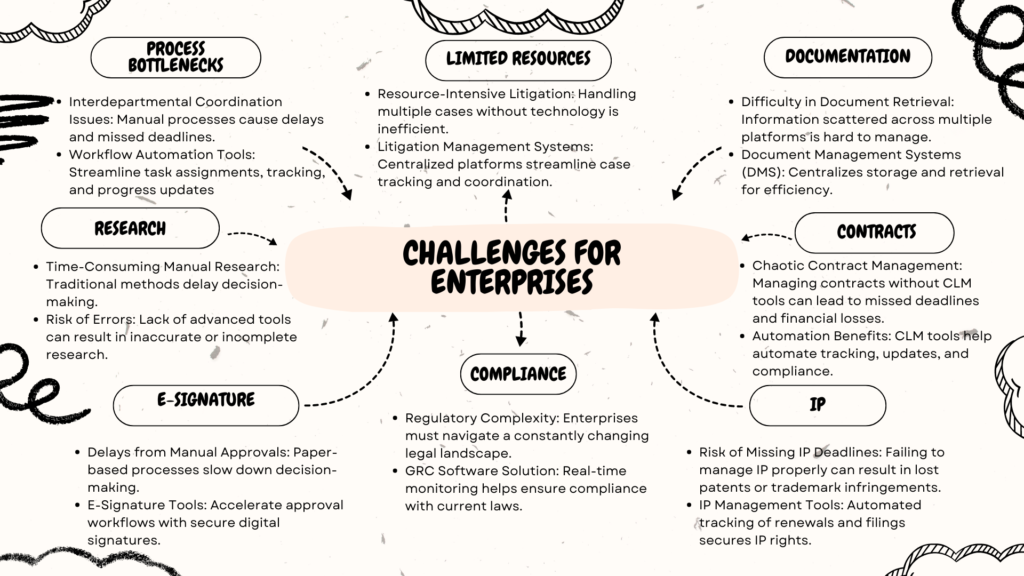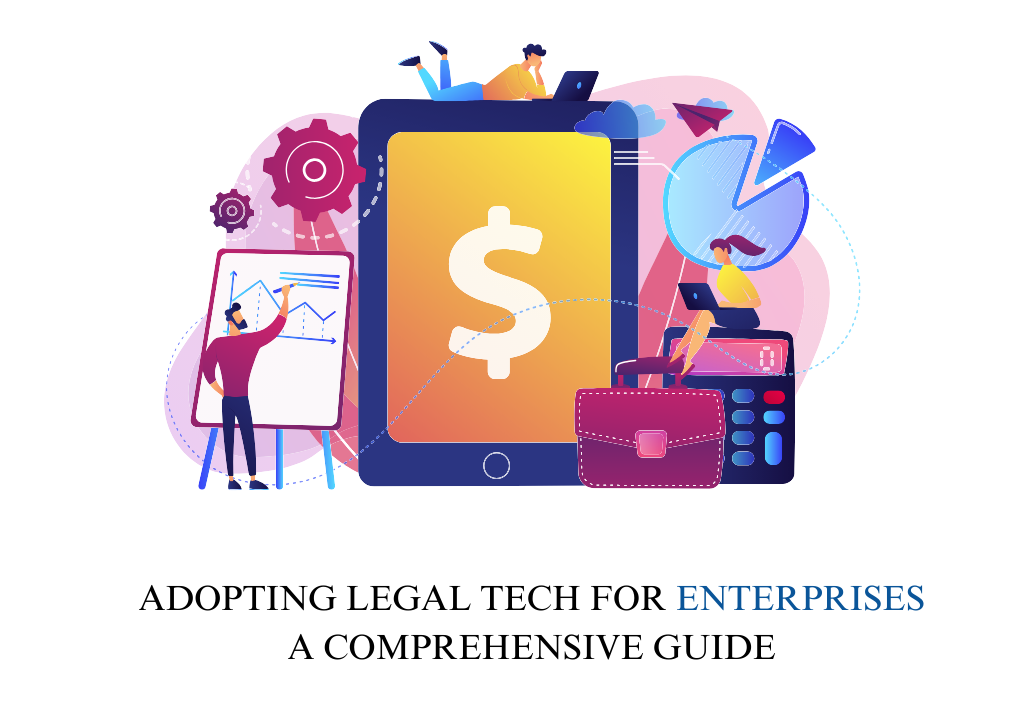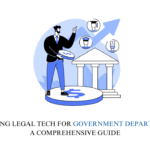Introduction to Legal Technology
In today’s fast-paced business environment, enterprises face an increasing number of legal challenges that require them to adapt rapidly. Managing large volumes of contracts, staying compliant with ever-evolving regulations, and coordinating cross-departmental tasks are just a few of the complex issues legal teams must navigate. For enterprises, legal technology is no longer a luxury but a necessity for maintaining efficiency, reducing risks, and achieving operational success.
Kickstarting the Legal Technology Journey for Enterprises
For enterprises, adopting legal technology is not just about improving efficiency—it’s about gaining a competitive edge, ensuring compliance, and safeguarding intellectual property (IP) in a complex regulatory landscape. The following strategic plan outlines the steps enterprises can take to integrate legal technology seamlessly into their operations, addressing key challenges and driving value across departments.
Challenges Faced by Enterprises
Enterprises face a diverse range of legal challenges, each of which can significantly impact day-to-day operations if not properly managed. Below are the key legal challenges enterprises encounter, and how legal technology can help solve them.

Phase 1: Strategic Assessment and Planning
- Conduct a Comprehensive Needs Assessment
- Organize Stakeholder Workshops: Conduct workshops with key stakeholders, including legal, compliance, IT, finance, and operations teams, to identify pain points and areas where legal tech can provide the most value. Discuss challenges such as managing numerous contracts, staying compliant with changing regulations, and protecting intellectual property.
- Map Out Current Legal Processes: Analyze existing processes like contract management, litigation tracking, compliance monitoring, and legal research to identify inefficiencies, redundancies, and risks. Use process mapping tools to visualize current workflows and pinpoint areas for improvement.
- Set Clear, Measurable Goals: Define specific objectives, such as reducing the time to approve contracts by 40%, increasing compliance monitoring efficiency by 50%, or automating 70% of manual research tasks. Clear goals will guide technology selection and implementation.
- Develop a Strategic Legal Tech Roadmap
- Create a Multi-Phase Legal Tech Roadmap: Outline a phased approach for implementing legal technology. Start with high-impact areas like contract management and compliance tracking, then move to more complex areas like litigation management and e-discovery.
- Prioritize Technology Investments: Rank legal tech solutions based on their potential impact and alignment with business priorities. For instance, if contract lifecycle management (CLM) is a major pain point, prioritize investing in a CLM system over other tools.
- Set a Budget and Timeline for Implementation: Develop a budget that includes costs for software, integration, training, and ongoing support. Establish a realistic timeline for each phase, ensuring there is room for testing, feedback, and adjustments.
Phase 2: Research and Solution Evaluation
- Identify and Evaluate Potential Legal Tech Solutions
- Research Legal Tech Vendors Catering to Enterprise Needs: Look for vendors with a strong track record of serving large organizations. Ensure they offer robust features for contract management, IP protection, litigation management, and compliance.
- Assess Security, Compliance, and Integration Capabilities: Enterprises handle sensitive data and must comply with stringent regulations (e.g., GDPR, CCPA). Ensure potential solutions offer data encryption, role-based access, audit trails, and seamless integration with existing enterprise systems (ERP, CRM).
- Request Demos and Run Proof-of-Concepts (POCs): Conduct POCs to test the functionality, usability, and integration capabilities of shortlisted solutions. Involve end users in the POC process to gather feedback on usability and effectiveness.
- Form a Cross-Functional Evaluation Committee
- Assemble an Evaluation Team with Key Stakeholders: Include representatives from legal, IT, compliance, procurement, and operations departments. This team should evaluate solutions from different perspectives to ensure they meet both technical and operational needs.
- Define Evaluation Criteria and Scoring Metrics: Create a scoring matrix based on criteria such as ease of use, scalability, integration, vendor support, compliance features, and total cost of ownership.
- Engage End Users for Feedback During POCs: Collect feedback from end users to ensure the selected solutions are user-friendly and effectively address their pain points.
Phase 3: Pilot Testing and Customization
- Pilot Legal Tech Solutions in Specific Departments
- Select High-Impact Departments for Pilot Testing: Choose departments where the legal tech solution can have a significant impact. For example, pilot contract management software in procurement and sales departments where contracts are frequently created and negotiated.
- Monitor Key Performance Indicators (KPIs) During the Pilot: Track KPIs such as contract processing time, compliance errors, and user satisfaction. Use both quantitative and qualitative feedback to identify any challenges or areas that require further customization.
- Customize Solutions Based on Pilot Feedback: Work with vendors to fine-tune the technology to better fit the organization’s needs. This could include configuring specific workflows, creating custom dashboards, or enhancing security settings.
- Implement a Comprehensive Change Management Strategy
- Develop a Change Management Plan: Address potential resistance to change by communicating the benefits of the new technology, providing clear instructions, and setting expectations for the transition.
- Appoint “Change Champions” Across Departments: Select individuals within each department to serve as “change champions” who will promote the benefits of the technology, assist peers, and provide feedback to the project team.
Phase 4: Full-Scale Implementation and Training
- Implement the Technology Organization-Wide
- Roll Out Technology in a Controlled Manner: Deploy the technology gradually across departments, starting with those most prepared for the change or where the technology will have the greatest impact. This phased rollout helps to manage risk and allows for adjustments based on early feedback.
- Ensure Secure and Accurate Data Migration: Collaborate with IT and legal teams to ensure a seamless migration of data from legacy systems to new platforms. Conduct multiple rounds of testing to ensure data accuracy and integrity.
- Develop and Execute a Robust Training Program
- Offer Role-Specific Training Modules: Create tailored training sessions for different roles, focusing on how each team will use the new technology. Legal teams may focus on advanced research and compliance tracking tools, while procurement teams focus on contract lifecycle management.
- Create Continuous Learning Opportunities: Provide ongoing training through webinars, advanced workshops, and e-learning modules. Ensure there is a helpdesk or dedicated support team available for quick troubleshooting and support.
- Establish Ongoing Support and Maintenance Structures
- Set Up a Centralized Support Team: Create a dedicated support team to assist users, handle technical issues, and work with vendors on any required updates or bug fixes. Ensure the support team is well-versed in the technology and understands the business processes it supports.
Phase 5: Monitoring, Evaluation, and Continuous Improvement
- Monitor Technology Performance and Gather Feedback
- Track Key Metrics and Measure ROI: Continuously monitor KPIs such as time saved, compliance adherence, user adoption rates, and cost savings. Use these metrics to measure the ROI of the technology.
- Collect Regular User Feedback and Conduct Reviews: Schedule regular feedback sessions, surveys, and performance reviews to gauge user satisfaction and identify areas for improvement.
- Optimize and Scale Technology Solutions Across the Enterprise
- Refine Processes and Automate More Tasks: Use insights from the pilot and initial rollout to further optimize workflows and automate additional tasks. For instance, automate contract renewal reminders or compliance reporting to reduce manual work.
- Expand Implementation to More Departments: Once initial rollouts prove successful, scale the technology to additional departments. Integrate other legal tech tools, such as AI-driven legal research platforms or advanced billing systems, to complement existing solutions.
- Stay Ahead with Legal Tech Innovations
- Encourage Participation in Industry Conferences and Webinars: Keep legal and compliance teams updated on the latest trends and innovations in legal tech by encouraging them to attend relevant conferences, webinars, and workshops.
- Create a Culture of Continuous Improvement and Innovation: Foster a culture where employees are encouraged to suggest new technologies or process improvements, ensuring the enterprise remains agile and ahead of competitors.
- Conduct Regular Technology Audits and Strategy Reviews
- Schedule Periodic Technology Audits: Conduct regular audits to evaluate the effectiveness of the legal tech solutions, identify gaps, and make necessary adjustments to align with evolving business needs and regulatory changes.
Best Legal Tech For Enterprises
Contract Lifecycle Management (CLM)
- Purpose: Automates the creation, negotiation, execution, and management of contracts.
- Key Features:
- Centralized contract repository for easy access and storage.
- Automated alerts for renewal dates, expirations, and compliance requirements.
- AI-powered contract drafting and analysis to identify risks or non-standard terms.
- Benefits for Enterprises:
- Reduces contract-related risks and improves compliance.
- Increases efficiency by automating contract workflows.
- Enhances collaboration between legal teams, business units, and external parties.
E-Discovery Solutions
- Purpose: Helps enterprises manage electronic data for litigation, investigations, and regulatory compliance.
- Key Features:
- Automated data collection and processing from various sources (emails, databases, cloud storage).
- AI and machine learning to classify, filter, and prioritize relevant documents.
- Built-in legal holds to ensure compliance with discovery obligations.
- Benefits for Enterprises:
- Streamlines the discovery process, saving time and reducing legal costs.
- Ensures compliance with litigation and regulatory requirements.
- Minimizes risks of fines and sanctions by safeguarding sensitive information.
Compliance Management Software
- Purpose: Tracks, manages, and ensures adherence to regulatory obligations across various jurisdictions.
- Key Features:
- Automated monitoring of regulatory updates and industry-specific requirements.
- Integrated policy management and compliance workflows.
- Audit trails and reporting to demonstrate compliance efforts.
- Benefits for Enterprises:
- Reduces risks of regulatory breaches and associated fines.
- Ensures all departments are aligned with compliance standards.
- Simplifies audits and reporting processes for regulatory bodies.
Conclusion
For enterprises, the adoption of legal technology represents a strategic move toward greater efficiency, risk management, and operational excellence. By following a structured approach that includes a thorough needs assessment, careful tool selection, tailored implementation, and ongoing optimization, enterprises can unlock the full potential of legal technology. Embracing this process not only addresses current challenges but also equips enterprises to stay agile and competitive in a rapidly evolving business landscape.

